-
Posts
2,097 -
Joined
-
Last visited
Content Type
Profiles
Forums
Gallery
Events
Blogs
Posts posted by jonathan
-
-
Although I have just noticed on the FLO clearance section that theres a Celestron Omni XLT 150 that comes with a CG-4 mount and is now only £330

This would be a nice option for an introduction to visual, within your budget so you will be able to afford either a nice high magnification eyepiece (not something you would need for photography, but would increase your viewing pleasure) such as the Celestron X-Cel LX 5mm, or a dew shield (some people make their own from a £5 camping mat, if you are that way inclined.. I prefer to buy a pre-made Astrozap one - I am told that the 6" Cele SE Notched fits the 150P) and maybe a red LED torch. This set up would be mainly for visual though, for serious imaging you would probably need to replace most of it with bigger and better stuff, though with a DEC motor you should be able to get some decent results using your camera lenses (mounted directly to the mount) or through the telescope using the camera body attached to the focuser via the relevant adaptors. A dew shield is something that will be useful for both visual and photography, as it reduces the chances of being dewed-out and also reduces the amount of stray light entering the tube, e.g. from nearby street lights.
I'm considering buying the 5mm eyepiece myself for the 150P I just took delivery of, the 150P looks pretty much the same as the OTA on that deal they have on FLO that you mention. Not sure how good it will perform from my back garden, will depend hugely on seeing conditions. A 7mm or 12mm will be slightly more forgiving of less than ideal seeing conditions; I do hear that a fast scope such as this (f5) requires high quality eyepieces to get the most out of it.. i.e. better than the ones supplied with the scope.
£400 is a drop in the ocean for a proper imaging set up, that wouldn't even buy you a decent enough 80mm OTA, not to mention mount, guide scope, dedicated camera (which themselves can cost thousands of pounds), which is why I dropped the idea and went for the 150P instead. After a couple of years at it I am still mainly visual, I was in your position before I bought my first telescope but the more questions I asked the more money it required and more confusing it all got! But maybe that is just me.
-
 1
1
-
-
For exceptional service on all orders I have placed since I got into this hobby, they go the extra mile and definitely deserve my repeat patronage. In my most recent order, which arrived the next day after I ordered, I received an additional little box containing a sachet of coffee and two Bendicks chocolate mints! Needless to say, those mints didn't get the chance to melt in my hands, and were very warmly received by my taste buds. Oh, and the telescope OTA and Cheshire Collimator I ordered arrived in tip-top condition.
Thank you, FLO.
-
 1
1
-
-
What exactly does Synscan do? I know a GOTO will point to the object you want using a computerized motor system, is Synscan/Syntrek the just a branded name for doing this? Also, is it possible to buy a mount such as an EQ5 and then add this feature later, or is that not possible?
In the Skywatcher line of mounts, Synscan is full Goto, Syntrek is usually the same mount and motors as Synscan but just a simple hand controller with no Goto. Both will automatically track.
I have the Syntrek NEQ6, I didn't want full Goto; depending on which mount you initially purchase, full Goto can be added later to a Syntrek by simply purchasing the Goto handset, it costs about £300 or £330.
General wisdom goes that on an EQ5 level mount you probably want tracking at the very least, because you are likely to be using it either for imaging or for high magnification, so turning knobs at this stage is going to be very tricky for keeping something in the eyepiece.
You could have an EQ5 Deluxe for £240 and add a DEC motor to it for £75, but for a major upgrade you could go for the HEQ5 Syntrek for £615, I can only go by the product description but apparently it has upgraded gears and motors for more accurate tracking, and will accept the Synscan handset as a quick and easy Goto upgrade (the other EQ5 mounts require a motor upgrade too, I think).
Have a good read through of the product descriptions on FLO's Skywatcher mount pages...
At this point it comes down to money, how much are you prepared to pay? Consider future-proofing and what you might want in the future. A good mount bought now is something you won't have to worry about later, whether you decide to go for something big or something small, it's worth spending that little bit extra to get the good version.
-
What’s the difference between a CG-4 and a CG-4 Omni? I can’t seem to find this out anywhere but I’m sure I’ll feel like a fool when someone points out something obvious

I'm not entirely sure either! I have the Omni, I think it is probably just an updated version, perhaps because it has thicker tripod legs.
-
I agree with bukko, start small and work your way up. You may be surprised at what you can do with even a small zoom lens, a DSLR, and a well set up mount.
One thing that foxed me was focusing when the moon wasn't up, my 1000D DSLR generally doesn't see the stars well enough to get a focus fix. I'm sure there are methods, but I didn't look too deeply into it. I have since acquired two new mounts, both of which have tracking, so may give this another go with my 1000D and 55 - 250 zoom lens.
-
I can find the 150P (or 150PL...?) tube for about £190, the CG-4 mount for £220 and the motor drive for £90, totalling £500 like you said
 , although I may leave the motor for a month or so to keep within my budget and so that I appreciate it more when I get it
, although I may leave the motor for a month or so to keep within my budget and so that I appreciate it more when I get it  , do I then have to buy the rings and dovetail to put the tube on the mount, or is that supplied?
, do I then have to buy the rings and dovetail to put the tube on the mount, or is that supplied?The tube rings and dovetail should come supplied with the 150P, and probably the 150PL too (confirm it with the vendor before buying). I bought DEC and RA motors for my CG-4 Omni, it cost about £122 for the complete package and were a doddle to fit.
I'm not saying that the CG-4 Omni mount is the best for photography, but it is a step up from the EQ3-2 (they are virtually identical to look at, both are equatorial mounts, but the CG-4 comes with substantially thicker tripod legs which will help to reduce vibration caused by touching the scope, and also from breezes). Each step up the mount weight category increases the price, and it doesn't look like you want to spend £850 on an NEQ6 straight away (which is probably the top end of the standard reasonably-priced EQ mounts, after that it goes into silly money for huge contraptions). For your budget, I think the CG-4 should be a good intro for you to visual and photography, and if you do upgrade to an EQ5 or whatever later, the CG-4 would still make a good grab and go or travel mount.
If you don't care what you are looking at or where it is in the sky, then a full Goto is probably what you're after, but they come at a price, and for serious imaging you also really need to know how to perform precise polar and drift alignment. Without motors you won't be able to do much in the way of imaging anyway, though you may be able to do some short exposures on the brighter planets and moon (some people turn the slow motion controls by hand).
I would say it's best to learn the ropes first, then add motors later when funds allow. Visual observing can be very rewarding, less time spent setting up and less stress worrying about alignment, and whether or not the clouds will roll by half an hour into the session.
-
 1
1
-
-
I think you should start small, as astrophotography is a very large area (like the night sky). Aim for the easy stuff first (moon, planets, Orion Nebula perhaps), repeat what others have done before you and gradually learn your way towards bigger things both in terms of your knowledge and equipment. Reading forum advice is like trying to read theoretical physics sometimes for me, I don't have a clue what they're on about until I actually get my hands on the mount / scope and try it for myself. Focal lengths and ratios are just numbers to me, I just want to look through my telescope and see stuff.

I bought an NEQ6 mainly to get rid of the vibrations, it certainly did the trick, but I also have a smaller CG-4 mount as it is far lighter and easier to handle for quicker sessions, and requires fewer accessories to run (batteries etc) and thus fewer trips to and from the house to set up / take down. A CG-4 is probably enough to do some light astrophotography, too; to me, the CG-4 looks like a better mount / tripod than the EQ3-2, you can buy the Skywatcher 150P OTA and a CG-4 separately, and get motor drives for RA and DEC with hand controller, though this set up is likely to cost closer to £500.
Nothing beats a pair of binoculars for quick observing though, going through the Moore Winter Marathon really has been an eye-opener as to how much can be seen without the use of a telescope. I would strongly suggest giving this a go, it will increase your knowledge of the night sky and give you some targets to think about too.
-
 1
1
-
-
Apologies for hijacking a thread, but has anyone tried this Hyperion zoom and barlow with an LS60 solar scope?
-
I fear that China and a few of the other emerging economies are the only ones who can actually afford a massive space programme at the moment, the US and Europe are in massive debt right now. Let China do some hard money-spending and lay the foundations for deeper space exploration, I say, it doesn't look like anyone can stop them anyway.
-
I think my Maplins 5-in-1 starter tank has bit the dust, might try the Optimates charger on it but am trying to get hold of a deep cycle AGM battery to replace the one inside (along with a suitable deep cycle charger). It just happens that when I enquired about it this week the supplier were just in the process of bringing out a new range of batteries which were not available yet, hopefully it won't be too long before I can buy one off the shelf at my local auto-parts trade counter. Should be no more than about £60 for the battery and charger, but definitely worth it over the cheap car batteries.
If anyone tries to recommend you a 'Leisure' battery, these are very large and typically used in caravans to run TVs and such, about 60Ah and above. Heavy and bulky, and probably far more Ah than could be used on one telescope in a typical night's observing. Gel batteries were also mentioned during my enquiries, but not recommended by the battery supplier / manufacturer for a 12v 2A deep cycle application such as a telescope mount. I am going to trust their advice on an AGM battery as the most suitable type, about 20Ah should be well within budget and more than enough to cover the mount, dew heaters, etc.
-
Just posting mine again since the original picture has been moved.
This is the kit that I use with my Celestron 8SE:
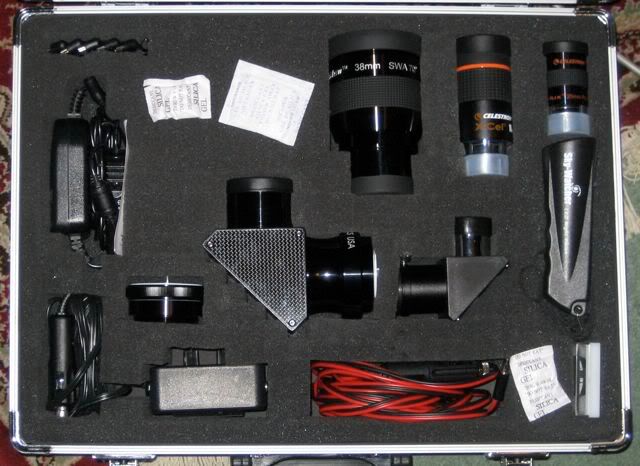
I use the large 2" diagonal pretty much all of the time now as I have the Baader SteelTrack focuser fitted (which is 2" only), the diagonal came with a 1.25" adaptor so I can still use my smaller eyepieces.
Dew header controller and power lead on the bottom left, mount power cable in red/black, filters on the bottom right (there are two more down there now).
I haven't actually used the 12v adaptor yet (left).
-
Having just purchased a wee Startravel 80 I can now make use of the metal case I purchased from a car boot sale for all of £4, it already had some foam lining, I just added a foam divider and a foam insert which came from some packing.
Does the job very well for the Startravel on an EQ1, there are no electronics to worry about and only three eyepieces (one is a barlow actually). The left hand compartment contains the tools that came with the Startravel (a screwdriver, spanner, and combi spanner tool thing, embedded in more foam), a foam layer, then the carry strap for the case. The cleaning fluid and small field manual for the telescope just sit loose in the case on top of the eyepieces for now.
Not sure what else I would put in here, but I'm sure there'll be something!
This should be excellent for getting out on the road with my small telescope, now all I need is a similar case for the OTA.
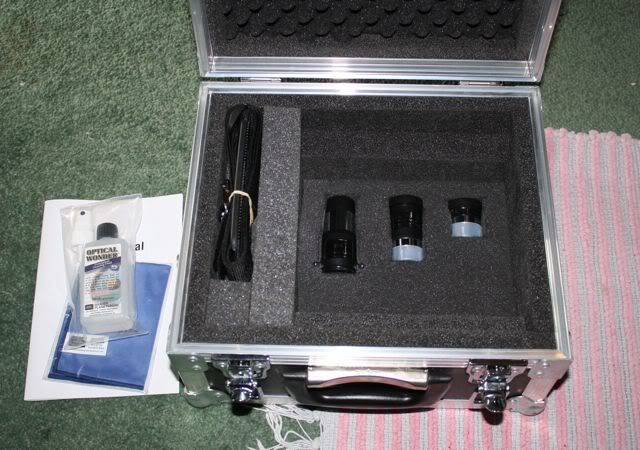
-
I just had my first go last night, quite surprised at how relatively easy it is to get basic star constellations. Anyway, here are my efforts! No stacking, just a few tweaks with curves in GIMP. Canon 1000d on an old camera tripod, kit 18-55 lens & 55-250 for Saturn.
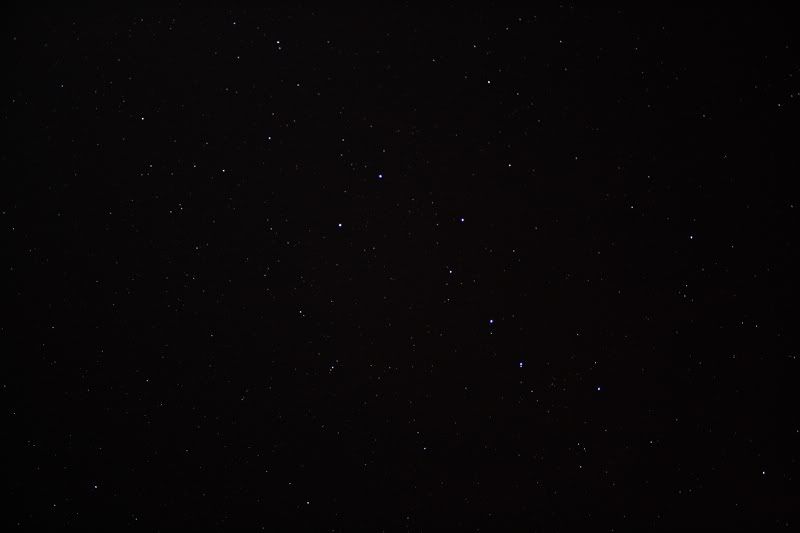
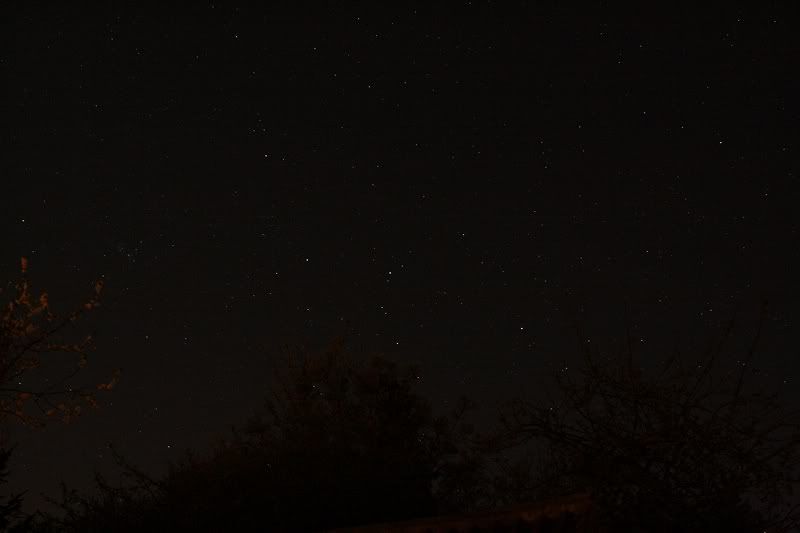
I tried to get some foreground objects in this one, the neighbour had a security light on which lit the tree and our buildings a bit, but they're still very dark in this picture. Couldn't really get any longer exposure without getting star trails.
Not bad at all for my first real attempt! I had a go with film years ago but I didn't have a clue what I was doing and barely got anything back from the developers (they didn't bother to process half of the 'empty' negatives, hmph!)
Not a DSO but on the same night had a quick go at Saturn too..
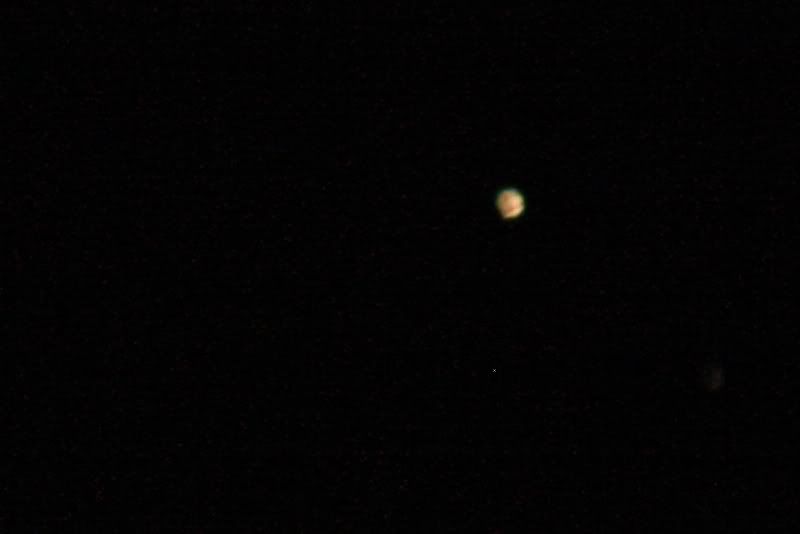
At least, I think that was Saturn.. it was in the right part of the sky and I think I can make out the shadow of the rings.
-
My case has become a little more populated...

Perhaps room for one or two small eyepieces, filters, or other small items; the torch is just sitting on top of the foam for now. I'm thinking I may need to get another case already!
-
I've ordered from them at least three times now and on every occasion it's been a pleasure - friendly and informative replies to emails, very fast delivery (nicely packed too), I've nothing but praise for them so far.
-
I bought the £19.99 Maplins Flight Case (currently reduced from £29.99) which arrived today, couldn't wait to get it home so that I could tidy up my kit! It's been hanging around on my table looking like it might get lost any second.
As you may be able to tell, I've only just started collecting...

The star diagonal is the one that came with the telescope, however I'm planning on buying a 2" one so that I can use a PanaView 38" eyepiece (also on the shopping list). I'm hoping they might both fit the same hole (at a pinch).
Not sure where to put the eyepieces yet, I suppose it doesn't really matter, I was thinking about across the top. I'm not planning on having more than four, but the best laid plans of mice and men etc. Question is, do I save space by not having them in the bolt tube? Can't really see them coming to any harm, being surrounded by foam, and if I always put the caps back on there should be no chance of bits getting in. Might be an idea to keep one bolt tube handy just in case I lose a cap.
When pulling out the foam I pulled it out all the way to the bottom (I had a half-hearted stab as pulling out only half way down but that ended up in a mess); by pulling the foam out in complete blocks I then cut them in half (horizontally) and put half back in the hole, this left a nice shelf on which to put items instead of them going all the way to the bottom of the hole. There is a very thin layer of hard foam at the bottom (glued to the inside of the case I think) so some of my items do go all the way, such as the AstroZap dew controller and main power cable (the big red and black one). The dew controller power cable (does not detach from the controller) has it's own half-depth slot to keep it tidy.
The eyepieces should easily fit upright in the foam, even with a 1cm block of foam at the bottom of the hole, however I think I would just feel more secure if they were flat as this would afford them the best protection from knocks.








RIP Sir Patrick
in The Astro Lounge
Posted
I'm the proud owner of several books bearing Patrick Moore's name, many of them I've owned since before I can remember (I used to trace the spacecraft). I don't expect them to rocket in value (ho ho) but I certainly intend to keep hold of them even more now.